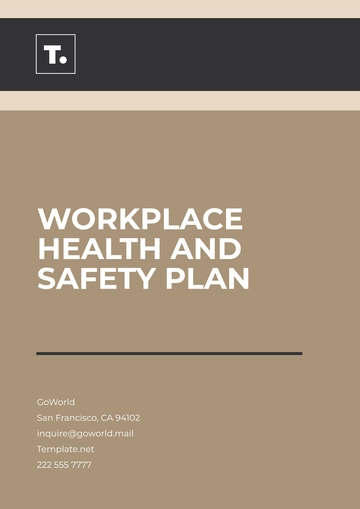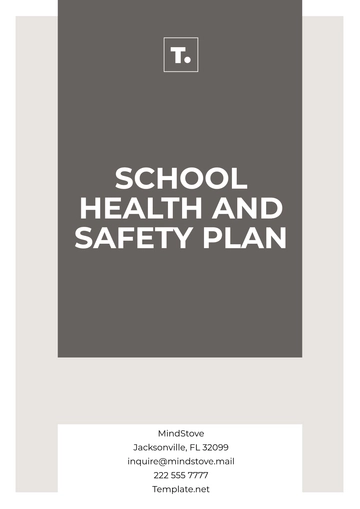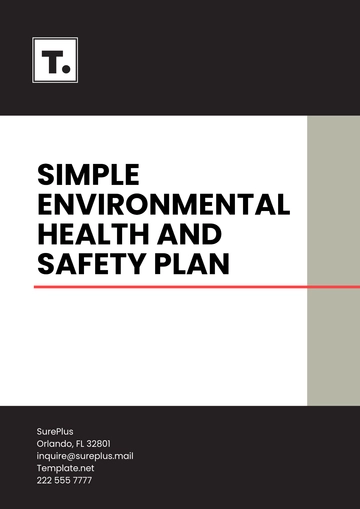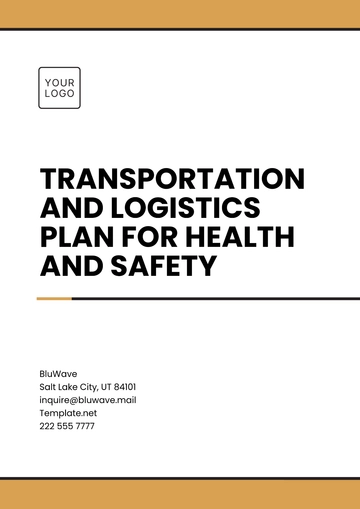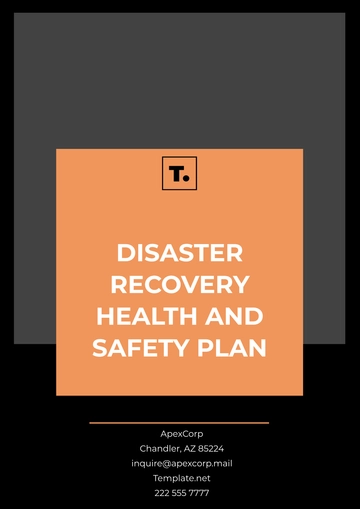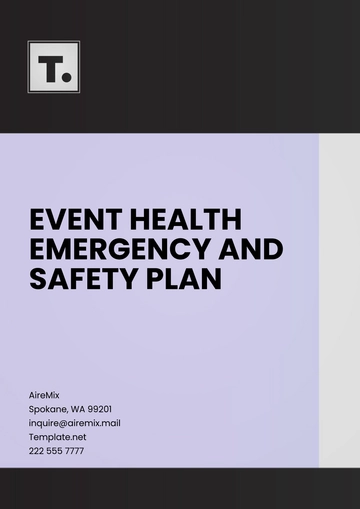Free Agriculture Biosecurity Management Plan

I. Executive Summary
This Agriculture Biosecurity Management Plan of [Your Company Name] outlines the comprehensive measures we will implement to protect our agricultural operations from biosecurity threats. This plan details protocols and procedures aimed at preventing, detecting, and responding to biosecurity risks that could impact the health and productivity of our crops and livestock. It is designed to safeguard our business, ensure the safety of our food supply, and protect the environment.
This plan includes key strategies such as risk assessment, monitoring, and control measures, supported by staff training and stakeholder engagement. We have identified critical control points in our operations and developed specific actions to mitigate potential biosecurity threats. Our approach is proactive and integrates best practices in biosecurity management to maintain high standards of agricultural health and safety.
II. Risk Assessment
The following table outlines the primary biosecurity risks identified in our operations, their likelihood, and potential impact:
No. | Risk | Likelihood | Impact | Mitigation Measures |
|---|---|---|---|---|
1 | Pest Infestation | High | Severe | Regular monitoring, use of pesticides |
2 | Disease Outbreak | Medium | High | Vaccination, quarantine protocols |
3 | Contamination from Imports | Low | Moderate | Strict import controls, testing |
4 | Weather-related Incidents | Medium | Severe | Crop rotation, weather monitoring |
A. Pest Infestation
Likelihood and Impact: Pest infestation is a high likelihood risk with severe impact on crop yield and quality. Effective pest control measures are essential to mitigate this risk.
Mitigation Measures: Implementing regular monitoring and using appropriate pesticides helps in early detection and control of pest infestations. Integrated pest management practices are also employed to reduce dependency on chemical pesticides.
B. Disease Outbreak
Likelihood and Impact: Disease outbreaks pose a medium likelihood but high impact risk, particularly for livestock. Controlling disease spread is crucial to maintaining animal health.
Mitigation Measures: Vaccination programs and quarantine protocols are essential to prevent and manage disease outbreaks. Regular health checks and biosecurity audits ensure compliance with disease control measures.
C. Contamination from Imports
Likelihood and Impact: While the likelihood of contamination from imports is low, its impact can be moderate, affecting both crops and livestock. Strict controls are necessary to prevent contamination.
Mitigation Measures: Implementing strict import controls and testing imported materials for contaminants helps mitigate this risk. Adhering to international biosecurity standards ensures safe imports.
D. Weather-related Incidents
Likelihood and Impact: Weather-related incidents have a medium likelihood but severe impact, particularly affecting crop production. Preparing for adverse weather conditions is essential for crop protection.
Mitigation Measures: Crop rotation and weather monitoring systems help mitigate the impact of adverse weather. Investing in resilient crop varieties and irrigation systems also enhances weather preparedness.
III. Monitoring and Surveillance
The following table details the monitoring and surveillance activities we have in place, including their frequency and responsible personnel:
No. | Activity | Frequency | Responsible Personnel |
|---|---|---|---|
1 | Pest Monitoring | Weekly | Field Supervisors |
2 | Health Checks for Livestock | Bi-monthly | Veterinary Team |
3 | Soil and Water Testing | Quarterly | Environmental Scientists |
4 | Surveillance of Imports | Each Shipment | Quality Control Inspectors |
A. Pest Monitoring
Frequency and Personnel: Pest monitoring is conducted weekly by field supervisors to ensure early detection and control. Regular monitoring helps in maintaining pest-free crops.
Methodology: This activity is vital for preventing pest infestations. Field supervisors use traps, visual inspections, and sampling techniques to identify pest presence and implement control measures promptly.
B. Health Checks for Livestock
Frequency and Personnel: Bi-monthly health checks for livestock are conducted by the veterinary team. These checks ensure that livestock remains healthy and free from diseases.
Methodology: Regular health checks help in early detection of diseases, allowing for timely interventions. The veterinary team performs physical examinations, vaccinations, and diagnostic tests as part of these checks.
C. Soil and Water Testing
Frequency and Personnel: Soil and water testing is conducted quarterly by environmental scientists. This testing ensures that soil and water quality meets agricultural standards.
Methodology: Maintaining soil and water quality is crucial for healthy crop growth. Environmental scientists collect samples and perform laboratory analyses to detect any contaminants or imbalances.
D. Surveillance of Imports
Frequency and Personnel: Surveillance of imports is performed for each shipment by quality control inspectors. This surveillance ensures that imported materials are free from contaminants and pests.
Methodology: Ensuring the biosecurity of imports is critical to prevent contamination. Quality control inspectors perform visual inspections and laboratory testing of imported materials to ensure compliance with biosecurity standards.
IV. Biosecurity Controls
The following table outlines the biosecurity controls implemented at various stages of our operations:
No. | Control | Stage | Description |
|---|---|---|---|
1 | Quarantine Protocols | Pre-entry | Isolation of new livestock before entry |
2 | Hygiene Measures | All stages | Regular sanitation of equipment and facilities |
3 | Secure Storage | Post-harvest | Safe storage of crops and produce |
4 | Transportation Controls | Distribution | Sanitization and secure transport of goods |
A. Quarantine Protocols
Stage and Description: Quarantine protocols are applied at the pre-entry stage to isolate new livestock before they join the main herd. This measure helps prevent the introduction of diseases.
Implementation: Implementing quarantine protocols involves setting up designated quarantine areas and monitoring new livestock for signs of illness. Regular veterinary checks are performed during the quarantine period.
B. Hygiene Measures
Stage and Description: Hygiene measures are critical at all stages of operations, ensuring regular sanitation of equipment and facilities. Maintaining high hygiene standards helps prevent the spread of contaminants.
Implementation: Hygiene measures include regular cleaning and disinfection of tools, machinery, and facilities. Staff training on hygiene practices is essential to ensure compliance and effectiveness.
C. Secure Storage
Stage and Description: Secure storage controls are implemented at the post-harvest stage to ensure safe storage of crops and produce. Proper storage prevents contamination and preserves product quality.
Implementation: Secure storage involves using appropriate storage facilities, maintaining optimal conditions, and regularly inspecting stored products. Ensuring that storage areas are pest-free is crucial.
D. Transportation Controls
Stage and Description: Transportation controls are essential at the distribution stage, ensuring the sanitization and secure transport of goods. Safe transportation practices prevent contamination during transit.
Implementation: Transportation controls include regular sanitization of transport vehicles and secure packaging of goods. Monitoring transport conditions and routes ensures that products reach their destination safely.
V. Training and Awareness
The following table details the training and awareness programs implemented to ensure that staff and stakeholders are knowledgeable about biosecurity protocols and practices:
No. | Program | Frequency | Target Audience |
|---|---|---|---|
1 | Biosecurity Workshops | Quarterly | Staff and Management |
2 | Stakeholder Meetings | Bi-annually | Suppliers and Partners |
3 | Online Training Modules | Monthly | Remote and Field Staff |
4 | Awareness Campaigns | Annually | Local Community and Public |
A. Biosecurity Workshops
Frequency and Audience: Biosecurity workshops are held quarterly for staff and management. These workshops ensure that all personnel are up-to-date with biosecurity protocols and best practices.
Content: Workshops cover topics such as pest control, disease prevention, and hygiene measures. Engaging in hands-on training and discussions helps reinforce learning and implementation of biosecurity measures.
B. Stakeholder Meetings
Frequency and Audience: Bi-annual stakeholder meetings involve suppliers and partners, ensuring they are aware of our biosecurity standards and expectations. Collaboration with stakeholders is vital for a cohesive biosecurity strategy.
Content: These meetings focus on aligning biosecurity practices across the supply chain. Open communication and cooperation with stakeholders help in maintaining consistent biosecurity measures.
C. Online Training Modules
Frequency and Audience: Monthly online training modules are available for remote and field staff. These modules provide flexible learning opportunities and ensure continuous biosecurity education.
Content: Online modules cover a range of topics, including risk assessment, monitoring techniques, and emergency response. Regular updates and assessments ensure staff competency in biosecurity practices.
D. Awareness Campaigns
Frequency and Audience: Annual awareness campaigns target the local community and public, educating them about biosecurity and its importance. Public awareness is essential for community support and compliance.
Content: Campaigns include informational materials, workshops, and community events. Raising awareness helps in fostering a culture of biosecurity and encouraging proactive measures.
VI. Emergency Response
The following table outlines the emergency response protocols in place for various biosecurity incidents:
No. | Incident Type | Response Time | Responsible Team |
|---|---|---|---|
1 | Pest Infestation | Immediate | Pest Control Team |
2 | Disease Outbreak | 24 hours | Veterinary Team |
3 | Contamination Detection | 12 hours | Quality Control Team |
4 | Natural Disasters | 48 hours | Disaster Response Team |
A. Pest Infestation
Response Time and Team: Immediate response by the Pest Control Team is crucial for managing pest infestations. Quick action helps contain and eliminate pests before they spread.
Response Protocol: The Pest Control Team uses integrated pest management techniques, including chemical and biological controls. Regular monitoring and follow-up actions ensure complete eradication.
B. Disease Outbreak
Response Time and Team: A 24-hour response time is critical for managing disease outbreaks, led by the Veterinary Team. Timely intervention helps prevent disease spread and protects livestock health.
Response Protocol: The Veterinary Team implements quarantine measures, administers treatments, and conducts thorough investigations to identify the disease source. Continuous monitoring and health checks follow the initial response.
C. Contamination Detection
Response Time and Team: The Quality Control Team responds within 12 hours to contamination detection. Swift action helps prevent further contamination and ensures product safety.
Response Protocol: Contaminated materials are isolated and tested. The team conducts root cause analysis and implements corrective actions to prevent recurrence. Regular audits and inspections are part of the follow-up process.
D. Natural Disasters
Response Time and Team: The Disaster Response Team is mobilized within 48 hours of a natural disaster. Prompt response helps mitigate damage and ensure safety.
Response Protocol: The team assesses damage, secures affected areas, and coordinates with external agencies for support. Recovery plans and preventive measures are developed to enhance resilience.
VII. Documentation and Record Keeping
The following table details the documentation and record-keeping practices we have implemented to maintain accurate and comprehensive biosecurity records:
No. | Document Type | Frequency of Update | Responsible Personnel |
|---|---|---|---|
1 | Biosecurity Logbooks | Daily | Field Supervisors |
2 | Health and Safety Reports | Weekly | Health and Safety Officers |
3 | Import Inspection Records | Per Shipment | Quality Control Inspectors |
4 | Training Attendance Sheets | Per Session | Training Coordinators |
A. Biosecurity Logbooks
Frequency and Personnel: Biosecurity logbooks are updated daily by field supervisors. These logs provide a detailed record of biosecurity activities and incidents.
Importance and Use: Maintaining detailed logbooks ensures accountability and traceability of biosecurity actions. These records are essential for audits and continuous improvement efforts.
B. Health and Safety Reports
Frequency and Personnel: Health and safety reports are updated weekly by health and safety officers. These reports monitor compliance with biosecurity and safety protocols.
Importance and Use: Regular reporting helps identify potential risks and areas for improvement. Health and safety officers use these reports to ensure that biosecurity measures are effectively implemented.
C. Import Inspection Records
Frequency and Personnel: Import inspection records are maintained per shipment by quality control inspectors. These records document the inspection and testing of imported materials.
Importance and Use: Keeping detailed import records ensures that all imported materials comply with biosecurity standards. These records are vital for tracking the origin and condition of imports.
D. Training Attendance Sheets
Frequency and Personnel: Training attendance sheets are updated per session by training coordinators. These sheets track participation in biosecurity training programs.
Importance and Use: Accurate attendance records help monitor staff engagement in biosecurity training. These records are used to identify training needs and measure the effectiveness of training programs.
VIII. Conclusion and Next Steps
A. Conclusion
This Agriculture Biosecurity Management Plan of [Your Company Name] outlines the comprehensive measures we have implemented to protect our agricultural operations from biosecurity threats. This plan details our risk assessment, monitoring, and control measures, supported by robust training and stakeholder engagement programs.
The continuous improvement of our biosecurity practices is essential for maintaining a competitive edge in the agricultural industry. Our commitment to excellence in biosecurity remains unwavering, and we look forward to building on our achievements in the coming years. By maintaining high biosecurity standards, we aim to safeguard our business, ensure the safety of our food supply, and protect the environment.
B. Next Steps
To further strengthen our biosecurity management, we will undertake the following next steps:
Implement Advanced Monitoring Technologies: Invest in new technologies to enhance our monitoring and detection capabilities.
Expand Training Programs: Increase the frequency and scope of biosecurity training sessions for all staff and stakeholders.
Enhance Collaboration: Foster closer collaboration with stakeholders to ensure alignment and support for biosecurity initiatives.
Allocate R&D Resources: Allocate additional resources for research and development to stay ahead of emerging biosecurity threats.
Develop Contingency Plans: Create detailed contingency plans for various biosecurity incidents to ensure rapid and effective responses.
By taking these steps, we will continue to improve our biosecurity measures and protect our agricultural operations from potential threats.
- 100% Customizable, free editor
- Access 1 Million+ Templates, photo’s & graphics
- Download or share as a template
- Click and replace photos, graphics, text, backgrounds
- Resize, crop, AI write & more
- Access advanced editor
Generate effortlessly with our Agriculture Biosecurity Management Plan Template from Template.net! This fully editable template allows for precise customization to your biosecurity measures. Customizable sections enable seamless integration of your business branding. The AI Editor Tool streamlines the creation process, ensuring an effective management plan tailored to your specific requirements!
You may also like
- Finance Plan
- Construction Plan
- Sales Plan
- Development Plan
- Career Plan
- Budget Plan
- HR Plan
- Education Plan
- Transition Plan
- Work Plan
- Training Plan
- Communication Plan
- Operation Plan
- Health And Safety Plan
- Strategy Plan
- Professional Development Plan
- Advertising Plan
- Risk Management Plan
- Restaurant Plan
- School Plan
- Nursing Home Patient Care Plan
- Nursing Care Plan
- Plan Event
- Startup Plan
- Social Media Plan
- Staffing Plan
- Annual Plan
- Content Plan
- Payment Plan
- Implementation Plan
- Hotel Plan
- Workout Plan
- Accounting Plan
- Campaign Plan
- Essay Plan
- 30 60 90 Day Plan
- Research Plan
- Recruitment Plan
- 90 Day Plan
- Quarterly Plan
- Emergency Plan
- 5 Year Plan
- Gym Plan
- Personal Plan
- IT and Software Plan
- Treatment Plan
- Real Estate Plan
- Law Firm Plan
- Healthcare Plan
- Improvement Plan
- Media Plan
- 5 Year Business Plan
- Learning Plan
- Marketing Campaign Plan
- Travel Agency Plan
- Cleaning Services Plan
- Interior Design Plan
- Performance Plan
- PR Plan
- Birth Plan
- Life Plan
- SEO Plan
- Disaster Recovery Plan
- Continuity Plan
- Launch Plan
- Legal Plan
- Behavior Plan
- Performance Improvement Plan
- Salon Plan
- Security Plan
- Security Management Plan
- Employee Development Plan
- Quality Plan
- Service Improvement Plan
- Growth Plan
- Incident Response Plan
- Basketball Plan
- Emergency Action Plan
- Product Launch Plan
- Spa Plan
- Employee Training Plan
- Data Analysis Plan
- Employee Action Plan
- Territory Plan
- Audit Plan
- Classroom Plan
- Activity Plan
- Parenting Plan
- Care Plan
- Project Execution Plan
- Exercise Plan
- Internship Plan
- Software Development Plan
- Continuous Improvement Plan
- Leave Plan
- 90 Day Sales Plan
- Advertising Agency Plan
- Employee Transition Plan
- Smart Action Plan
- Workplace Safety Plan
- Behavior Change Plan
- Contingency Plan
- Continuity of Operations Plan
- Health Plan
- Quality Control Plan
- Self Plan
- Sports Development Plan
- Change Management Plan
- Ecommerce Plan
- Personal Financial Plan
- Process Improvement Plan
- 30-60-90 Day Sales Plan
- Crisis Management Plan
- Engagement Plan
- Execution Plan
- Pandemic Plan
- Quality Assurance Plan
- Service Continuity Plan
- Agile Project Plan
- Fundraising Plan
- Job Transition Plan
- Asset Maintenance Plan
- Maintenance Plan
- Software Test Plan
- Staff Training and Development Plan
- 3 Year Plan
- Brand Activation Plan
- Release Plan
- Resource Plan
- Risk Mitigation Plan
- Teacher Plan
- 30 60 90 Day Plan for New Manager
- Food Safety Plan
- Food Truck Plan
- Hiring Plan
- Quality Management Plan
- Wellness Plan
- Behavior Intervention Plan
- Bonus Plan
- Investment Plan
- Maternity Leave Plan
- Pandemic Response Plan
- Succession Planning
- Coaching Plan
- Configuration Management Plan
- Remote Work Plan
- Self Care Plan
- Teaching Plan
- 100-Day Plan
- HACCP Plan
- Student Plan
- Sustainability Plan
- 30 60 90 Day Plan for Interview
- Access Plan
- Site Specific Safety Plan

